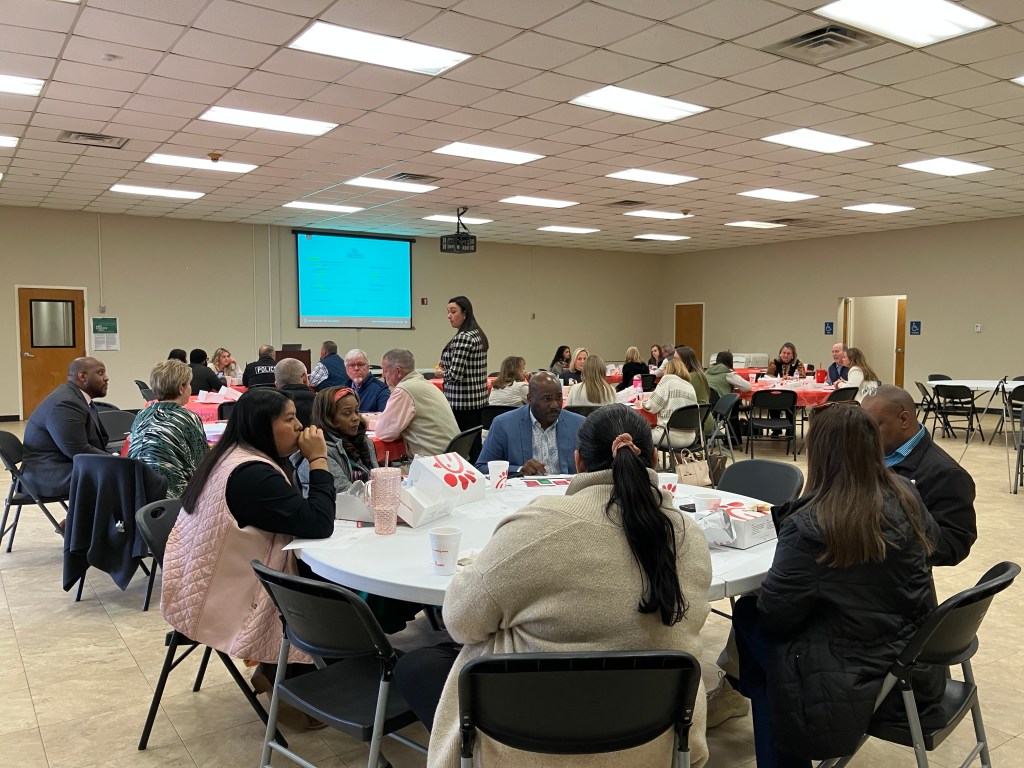Professionals from UGA present housing data at Housing Summit
Published 9:56 am Tuesday, January 21, 2025

- Approximately 40 people participated in the Archway Partnership Housing Summit, representing a variety of community entities including government, education, business, authorities, health and non-profits.
MOULTRIE — The Archway Partnership Housing Summit continued a community discussion on housing issues during a Wednesday meeting. Representatives of the UGA Carl Vinson Institute of Government presented data about housing in Colquitt County.
About 40 residents attended, representing a variety of community entities including government, education, business, authorities, health and non-profits.
Colquitt County Archway Professional Sara Hand welcomed the group, then turned the meeting over to research associate Ashlee Tziganuk of the Vinson Institute.
Trending
Tziganuk asked the group why housing would be important in developing a community and some of the answers she received were “so people would have a place to live and go to school,” “stability,” and “workforce development.”
Tziganuk said housing is a key to economic growth, it anchors and supports neighborhoods and it promotes individual health and well-being.
“Housing is a key component to creating communities that are economically healthy, physically healthy and socially healthy, as well,” she said.
She said there were many ways that people across the country have taken action around housing.
“And many of those initiatives fall into what Shane Phillips calls the three S’s in his book “The Affordable City,” Tziganuk said.
The three S’s are supply, subsidy and stability, she said and went on to explain each. “Supply” is about having enough housing for everyone, she said, and that much of the data she was presenting fell into that category. “Stability” is about finding ways to keep people in their homes, she said, so, there might be things like eviction prevention programs or home repair programs.
Trending
“And then, ‘subsidy’ is gonna involve federal, state and local funding to provide housing support … to account for those who are left behind by the private housing market,” she said.
Then, Tziganuk said that she wanted to point out that it took all of the categories to be successful. She also said that the group should keep in mind that she was giving them a “30,000-foot view,” a very high-level view of housing in Colquitt County.
“You all live here. You all work here. You’re local experts in this community. So, keep that in mind, too, that I might not cover everything that you’re seeing on the ground but we can definitely talk about that,” she said.
Next, Tziganuk moved on to the first topic, which was “demographics.” She said they were important because they want to know what kinds of people are living in the community and what their specific needs were.
She said, according to the data, it’s projected that Colquitt County would have a modest population growth by 2060 and the chart she presented showed that it has been increasing since 2000.
“So, even modest population growth can affect the housing market, especially if current supply is not meeting demand,” she said. “You might, as a county, think about expanding housing options to account for this population growth in the future.”
Another thing that Tziganuk pointed out was that the Hispanic population in Colquitt County was expected to grow by 2050, the Black population would stay the same and the white population would see a decrease.
“So understanding the racial ethnic composition can be important for housing because people of color have experienced barriers, especially for home ownership,” she said.
The next chart showed that, by 2050, the county’s elderly population is expected to increase by about 50%.
She said as the population continued to age, their housing needs were going to change.
“We have to think about accessibility within the home but also outside of the home,” she said and added that transportation would be a concern, especially if older residents could no longer drive. Also, she said, some of the seniors would be on a fixed income so affordability would become an issue.
The final slide that she showed in the demographics part of the presentation was about incomes in relation to rent.
The top industries in Colquitt County were agriculture, manufacturing, retail trade, health care and educational services. The chart showed the median income for each of the industries versus how much it costs to rent both a one-bedroom and a two-bedroom apartment.
“This is important in workforce housing,” she said.
The chart showed that none of the industries’ incomes were sufficient to rent a two-bedroom apartment and none of them except for the manufacturing and educational services incomes were able to afford a one-bedroom.
The key takeaways from the demographics data, she said, were enough housing needed to be created to meet a growing population, suitable housing was needed for an aging population, affordable workforce housing was needed and home ownership opportunities were needed for people of color.
Next, Tziganuk presented data on “home ownership” in Colquitt County, stating that 65% of individuals owned a home in Colquitt County. She also showed a break-down of home ownership based on race and ethnicity.
“So, what this is saying is that there might be some disparity in homeownership by race and ethnicity. … So, that’s something to consider moving forward, as well,” she said.
She presented a slide that showed the vacancy rate of homes in Colquitt County, which indicated, she said, a shortage of homes for sale. The data also shows, she said, that housing prices, in Colquitt County, have risen by 23% from 2020 to 2024.
She also pointed out that mortgage payments have doubled since 2020, on a 30-year fixed mortgage.
“This can really deter first-time home buyers,” she said, and fewer people were willing to sell their homes because they were locked-in to a lower interest rate.
The next chart showed cost burden, which she explained meant that people were spending more than 30% of their income on housing costs. She added that one out of five homeowners in Colquitt County were cost burdened.
She said the key takeaways on the home ownership data was affordable home ownership opportunities needed to be created and there needed to be increased homeownership among people of color.
The next group of slides that she presented dealt with “rentals.” She said the data showed that rental opportunities were especially important in Moultrie. because 54% of the people were renters. She said rental availability was important because it was an affordable option for housing.
The numbers also showed, Tziganuk said, that the rents have increased, overall, about 10% since 2020 and nearly half of renters spend more than 30% of their income on housing.
The key takeaways on rentals were that affordable rental options needed to be expanded and there needed to be rental assistance programs.
“So, this last section will be about the housing stock,” she said.
She said that there were about 16,000 households in Colquitt County and about 19,000 housing units. She said that most of the occupied housing was single-family homes.
“We also see that 26% of the county’s occupied housing is mobile homes and when we compare that to the state, the state only has 8%,” Tziganuk said. “In the US, mobile homes are the largest source of unsubsidized affordable housing.”
She also showed data that stated that 40% of the housing in Moultrie was built prior to 1970 where only 28% were built before then in Colquitt County.
She said the key takeaways on housing stock was that the community’s existing strengths were the availability of mobile homes and middle housing, which is two- to four-unit housing. She said considerations would be the security and financing of mobile homes, the quality of older housing stock and developing multi-family homes.
“So, that’s kind of hitting you over the head with all of the data, so let’s talk about some strategies or mechanisms moving forward,” Tziganuk said.
She presented slides that showed both government related strategies and community related strategies on supply, stability and subsidy.
Some of the government strategies included zoning reform, rent control, and housing choice vouchers. Some of the community strategies included Habitat for Humanity, tenant legal assistance and community-based housing assistance.
After the presentation, the participants were invited to have an open discussion on the data and the housing issues in the community.
Angela Hobby of the Colquitt County School System said that the “aging in place” data was a concern for the school system because, in general, they were seeing smaller and smaller class sizes.
She also gave the median income for the school system’s employees and said that they work really hard to stay competitive with the surrounding areas. She said out of 1,400 employees, they do have 253 that commute.
“One of the things we do talk about is, as we recruit new teachers, we have had a couple of instances where we struggled to help them find housing,” Hobby said.
Hobby said that she did think that a lot more of their employees would move to Colquitt County if there was more housing and many of them were looking for starter homes.
Dr. Matthew Clifton of Colquitt Regional Medical Center said that the hospital had about the same number of employees as the school system and they have a 35% of their employees, right now, driving in from outside the county.
Clifton said that was something the hospital was also struggling with, as far as finding housing for incoming medical professionals.
Caroline Horne, director of United Way, said that they had data through a project called ALICE (Asset Limited, Income Constrained, Employed) and they realized that almost 40% of Colquitt County is slightly above the poverty line.
“They’re right there at it and they do not get the benefit that the people below poverty do,” she said.
She went on to say that they are a working population that doesn’t make enough money to make ends meet and survive.





